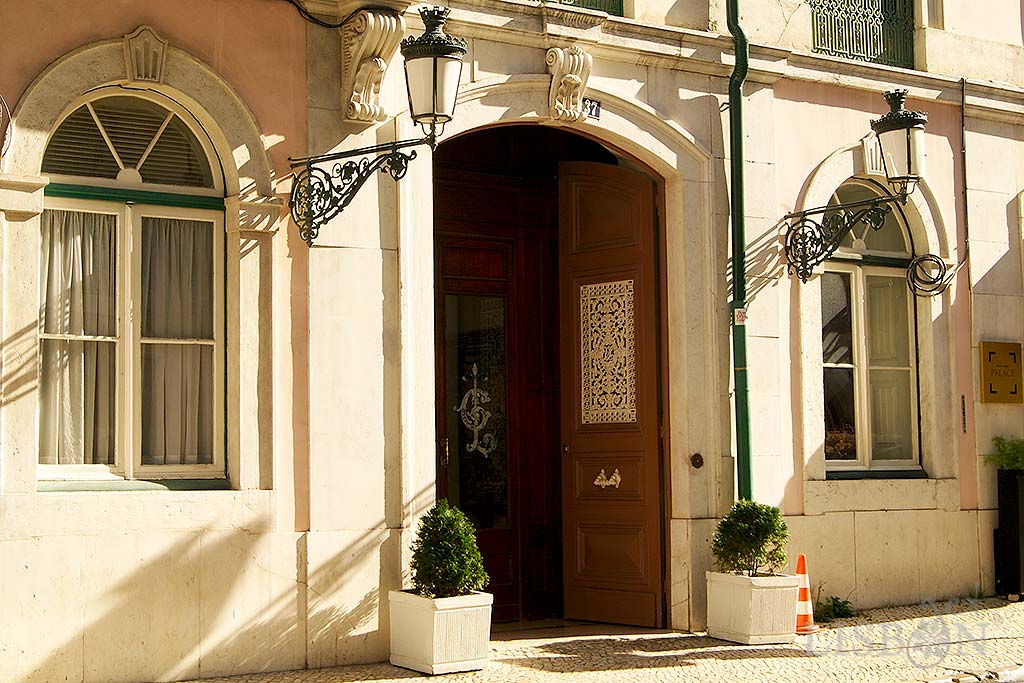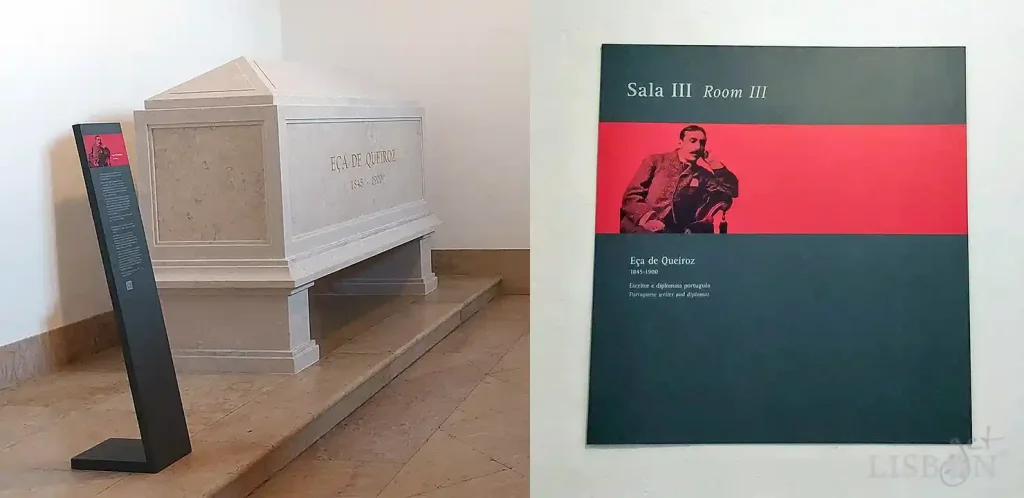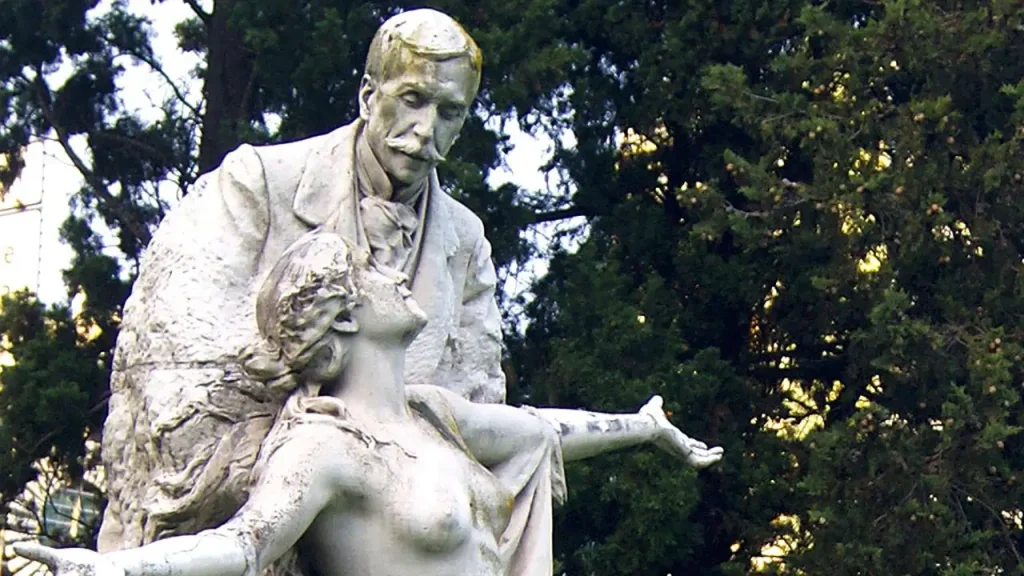Updated on 14 January 2025
Original article published on 25 November 2020
The writer Eça de Queiroz is unarguably, one of the most relevant Portuguese writers of all times. On the day he would turn 175 years old, we want to remember him, recalling his relationship with Lisbon.
The novelist, characterised by originality, richness of style and language, great realistic descriptive power, as well as by timeless social criticism, has his work translated into about 20 languages.
He’s the author of compelling novels in our literature such as: ‘The Maias‘, ‘The Sin of Father Amaro’, ‘The Relic’, ‘The Illustrious House of Ramires’, ‘The Mandarin’, ‘The City and the Mountains’…
From the realist movement of the 19th century, he’s one of the intellectuals of the famous 70’s Generation. Graduated in Law in Coimbra, he worked as a journalist and embraced the diplomatic career, having been consul in Havana, Newcastle, Bristol and Paris.
Born in Póvoa de Varzim on November 25, 1845, he died in Neuilly-sur-Seine, France, on August 16, 1900.
Get to know Lisbon’s historic neighbourhoods in a guided tour and discover unmissable places of this magnificent city.
The Writer Eça de Queiroz and Lisbon

Eça de Queiroz wasn’t born nor died in Lisbon, but his name is present in the city’s toponymy and one of its most beautiful sculptures is dedicated to him.
The brilliant writer wasn’t born nor died in Lisbon, but he lived here intermittently and said he felt at home in an institution based in Chiado.
The Portuguese diplomat wasn’t born nor died in Lisbon, but he was buried here for 89 years.
The timeless thinker wasn’t born nor died in Lisbon, but when he was here he went to places he described to us and in one of them today it is possible to observe a curious evocation dedicated to him…
The novelist wasn’t born nor died in Lisbon, but this city has a fundamental presence in his work.
It’s also in Lisbon that a guild has him as a patron.
This year, when 120 years have passed since his disappearance, we have yet another reason to honour him.
Evocations in Lisbon
Toponymic and Evocative Plaques
Rua Eça de Queiroz was established thirteen years after the death of the writer. It is located in the area of Marquês de Pombal Square, a discreet artery that connects Avenida Duque de Loulé to Rua Actor Tasso.
At no. 26 in Rossio, above Café Nicola, on the 1st floor there’s a sign that reads: “In this building, the great writer EÇA DE QUEIROZ lived and began his literary life. Tribute from the Círculo Eça de Queiroz and from the Sociedade de Escritores e Compositores Teatrais Portugueses – (1866-1966)”.
In fact, Eça lived for some time, starting in 1866, in his father’s place on the 4th floor of this building.
Monument of Eça de Queiroz

Just three years after his disappearance, a monument in his honour by Teixeira Lopes (1866-1942), was inaugurated in Barão de Quintela Square.
It’s a sculptural set composed by the figure of the writer who holds in his arms and looks in the eyes of the allegorical figure of Truth. A woman with open arms who’s only wearing a transparent mantle that models but doesn’t hide her naked body.
This symbolic composition is based on a phrase that is inscribed there, taken from his novel The Relic: “Over the powerful nakedness of Truth, the diaphanous look of Fantasy”.
Over time, the magnificent sculpture has suffered numerous acts of vandalism. For this reason, in 2001, the City Council of Lisbon decided to move the stone original to the gardens of the Lisbon Museum – Pimenta Palace, in Campo Grande, and to place a bronze replica.


Statue of the Writer Eça de Queiroz at the National Library of Portugal

Next to the building of the National Library of Portugal, in Campo Grande, there is a granite statue created in 1963 by Álvaro de Brée and inaugurated on April 10, 1969.
This is part of a set of four statues of figures of literature, namely: Fernão Lopes, Gil Vicente and Luís de Camões.
Grémio Literário

One of the most frequented places by Eça in this city was the Grémio Literário of Lisbon. A public benefit institution founded in 1846, by royal charter of Queen Maria II and D. Fernando II, which aims to promote the social interaction and intellectual activity among peers, in the field of literature.
It has been headquartered since 1875 in the palace of the Viscount of Loures in Rua Ivens, in the heart of Chiado. A magnificent romantic property from whose back we can see one of the best views of the city. Plus, it has a garden that the novelist called “my farm with a door to Chiado”.
In this garden, as well as in the library, the writer spent long periods reading and consulting so many French newspapers and magazines that they served as inspiration for the creation of his characters.
Alto de São João Cemetery
Eça de Queiroz died at the age of 55 in August 1900 in Neuilly-sur-Seine, outskirts of Paris at the time. In September, his body was received in Lisbon with State honours, having stayed in the Alto de São João Cemetery until 1989 when he was transferred to his family tomb in Santa Cruz do Douro, Baião.
Evocation in a Café in Príncipe Real

In Rua da Escola Politécnica no.103 there’s a patisserie founded in 1838, Confeitaria Portuguesa, which everyone used to call Serafina. In the 70s this famous café was renamed Cister and it is here that we’ll find a curious evocation to this personality.
Scattered throughout the space, we find several images that refer to the writer Eça de Queiroz. The most prominent are found on the wall on the left side of the room.
One of them is a medallion of inlaid marbles of different shades where his portrait is represented. here you can read an inscription: “Eça de Queiroz / In Serafina, today Cister, spent most of his days.”
Next to it there’s a framed embroidered piece made using the Arraiolos stitch, where we can see the unmistakable full-body figure of the novelist who, sitting at a table, reads the newspaper.
It seems safe to say that the writer Eça de Queiroz frequented this café every morning. From there he headed to Príncipe Real Garden, then further ahead he observed the city from the São Pedro de Alcântara Garden and finally went down Chiado until Rossio.
Círculo Eça de Queiroz

In the no. 4 of Rafael Bordalo Pinheiro Square is the headquarters of this institution, founded in 1940, that aims to contribute to the enrichment of the cultural level of the Portuguese society, as well as to divulge the life and work of the writer through the realization of conferences, exhibitions, concerts and other events in the cultural scope.
| Never miss another article | Subscribe here |
Lisbon, Character of Novels

Lisbon is home to many of Eça’s novels. Lisbon is not only in his greatest work ‘The Maias’, but also in: ‘The Tragedy of the Street of Flowers’; ‘Cousin Bazilio’; or ‘To the Capital’.
There are countless excerpts where Chiado, Bairro Alto, Campo Santana, Príncipe Real, Aterro are mentioned… or more peripheral areas such as Santa Apolónia, Penha de França, Benfica, Olivais…
Through his descriptions we get to know the streets, hotels, shops, cafés, gardens, houses, experiences with rigor.
However, the city is not just a scenic setting where actions take place. Lisbon appears personified, intervening and in permanent dialogue with the other characters who inhabit his extraordinary novels.
During the opening ceremony of the monument in honour of Eça de Queiroz, Ramalho Ortigão, his friend and also a writer, stressed: “It is not a literary portrait of the distinguished writer that I propose to draw – my aim is only to make Lisbon notice that Eça is, as a novelist, the most fundamental and genuinely local of Lisbon of all national writers”.
Eça de Queiroz in the Pantheon

When this article was written (Nov. 2020), it marked 120 years since the death of the writer. On that same date, the Eça de Queiroz Foundation, based at the Casa de Tormes in Baião, proposed the transfer of the writer’s remains to the National Pantheon, located in the Church of Santa Engrácia in Lisbon. This proposal was approved by the Portuguese Parliament in January 2022 and carried out on 8 January this year.
Eça de Queiroz now rests alongside illustrious writers such as Almeida Garrett, Aquilino Ribeiro, and Sophia de Mello Breyner, among others, occupying the long-deserved place of honour.
The project getLISBON has been very rewarding and we want to continue revealing the singularities of fascinating Lisbon.
Help us keep this project alive!
By using these links to make your reservations you’ll be supporting us. With no extra costs!
• Looking for a different experience? We can create a customised itinerary based on your interests. Contact us!
• Or if you prefer tours and other activities in various destinations, take a look at GetYourGuide.
• Save time and money with a flexible Lisbon Card!




